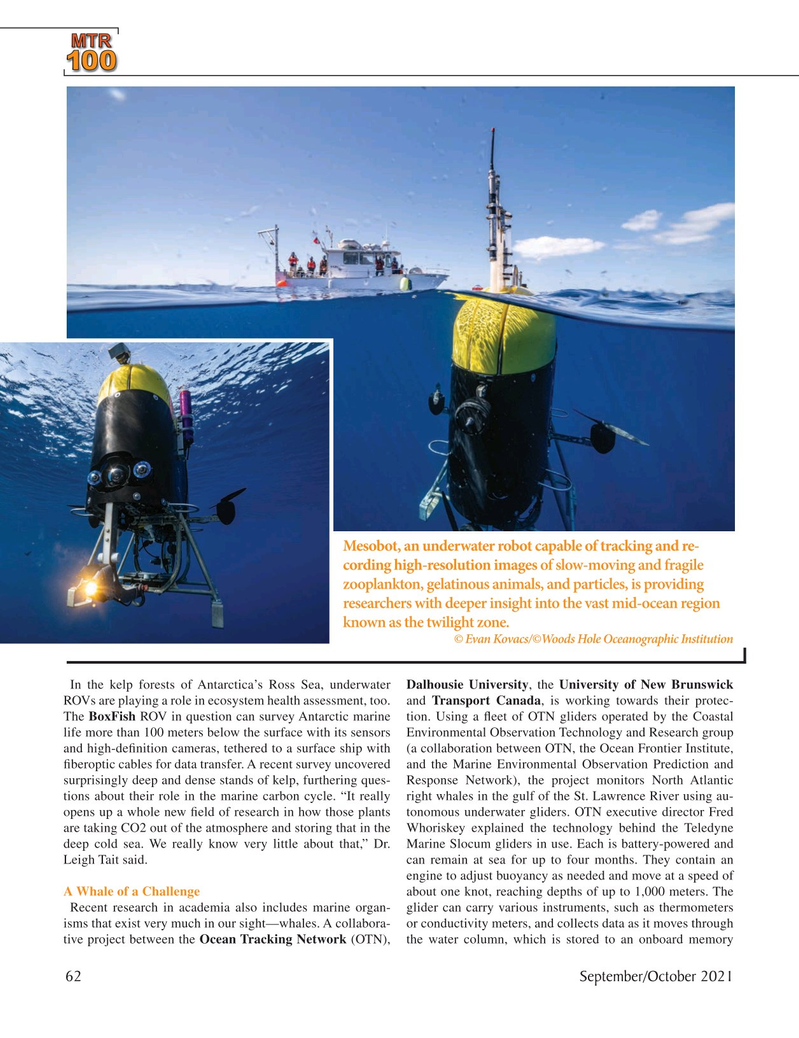
Page 62: of Marine Technology Magazine (September 2021)
MTR100: Focus on 100 Leading Companies, People and Innovations in the Subsea Space
Read this page in Pdf, Flash or Html5 edition of September 2021 Marine Technology Magazine
MTTTTTTTTTTTTTRM M M M M M M M M M M M M M M M M M M M M M M M M M M M MTRRRRRRRRRRRRRRRRRRRRRRRRRRRMTTTTTTTTTTTTTRMTR 100000000000000001111111111111111111111111111100000000000000000000000000000010000000000000000100
Mesobot, an underwater robot capable of tracking and re- cording high-resolution images of slow-moving and fragile zooplankton, gelatinous animals, and particles, is providing researchers with deeper insight into the vast mid-ocean region known as the twilight zone. © Evan Kovacs/©Woods Hole Oceanographic Institution
In the kelp forests of Antarctica’s Ross Sea, underwater Dalhousie University, the University of New Brunswick
ROVs are playing a role in ecosystem health assessment, too. and Transport Canada, is working towards their protec-
The BoxFish ROV in question can survey Antarctic marine tion. Using a ? eet of OTN gliders operated by the Coastal life more than 100 meters below the surface with its sensors Environmental Observation Technology and Research group and high-de? nition cameras, tethered to a surface ship with (a collaboration between OTN, the Ocean Frontier Institute, ? beroptic cables for data transfer. A recent survey uncovered and the Marine Environmental Observation Prediction and surprisingly deep and dense stands of kelp, furthering ques- Response Network), the project monitors North Atlantic tions about their role in the marine carbon cycle. “It really right whales in the gulf of the St. Lawrence River using au- opens up a whole new ? eld of research in how those plants tonomous underwater gliders. OTN executive director Fred are taking CO2 out of the atmosphere and storing that in the Whoriskey explained the technology behind the Teledyne deep cold sea. We really know very little about that,” Dr. Marine Slocum gliders in use. Each is battery-powered and
Leigh Tait said. can remain at sea for up to four months. They contain an engine to adjust buoyancy as needed and move at a speed of
A Whale of a Challenge about one knot, reaching depths of up to 1,000 meters. The
Recent research in academia also includes marine organ- glider can carry various instruments, such as thermometers isms that exist very much in our sight—whales. A collabora- or conductivity meters, and collects data as it moves through tive project between the Ocean Tracking Network (OTN), the water column, which is stored to an onboard memory 62 September/October 2021
MTR #7 (50-65).indd 62 9/21/2021 11:35:49 AM

 61
61

 63
63
